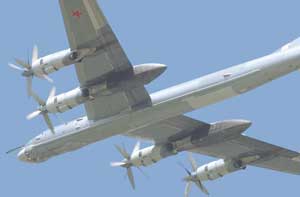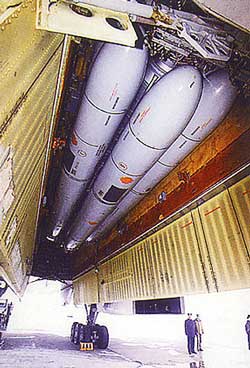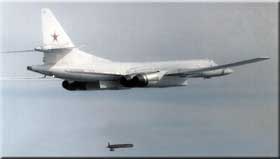|
 Russia
revealed it was fitting its strategic bombers with cruise
missiles capable of delivering a massive precision strike
thousands of miles away -- giving away the first clear
hint of its post-Cold War military strategy. Russia
revealed it was fitting its strategic bombers with cruise
missiles capable of delivering a massive precision strike
thousands of miles away -- giving away the first clear
hint of its post-Cold War military strategy.
"Russia's long-range air force finally
has a new weapon," the government's Rossiyskaya Gazeta
daily announced in a headline. "We now have a strategic
cruise missile with a non-nuclear warhead," the paper
wrote.
"We have broken the US monopoly on
the use of long-range conventional cruise missiles,"
an unnamed senior air force commander told ITAR-TASS.
 |
| Russian nuclear AS-15 Kent missiles loaded into
the bomb bay of a Tu-160 bomber. Each warhead is rated
at 800 kilotons. |
The technology appears to be similar to
cruise missiles that the United States has long attached
to its own intercontinental bombers like the B-2 Stealth
bomber.
The announcement followed months of cryptic
statements from President Vladimir Putin and his top generals
that Russia was developing a new missile program that
is a step ahead of any Western rivals -- including technology
developed by the United States.
Putin declared last month that Russia
had "conducted tests of the latest nuclear rocket
systems" in a cryptic comment that puzzled military
strategists but seemed aimed at Washington and its mooted
missile defense shield that Moscow considers illegal.
Russia has been developing a range of
new missiles capable of penetrating US defenses as a result.
Generals announced earlier this year the
successful tests of a hypersonic intercontinental missile
that has no officially-confirmed rival in the United States.
Moscow is also believed to be developing
a multi-stage intercontinental ballistic missile that
uses cruise missile technology to zigzag and avoid being
shot down once it re-enters the earth's atmosphere.
Finally Russia announced that it was making
its most feared and powerful trans-Atlantic missile mobile
within the next two years.
But the latest technology announced Monday
would see old Soviet-era conventional missiles be carried
by strategic bombers with a global range.
The Russian government daily said tests
of the new system were being conducted in military exercises
now under way in southern Russia.
 "This
year, our strategic Tu-160 and Tu-95s bombers have been
equipped with new non-nuclear precision weapons,"
ITAR-TASS quoted an unnamed Russian air force general
as saying. "This
year, our strategic Tu-160 and Tu-95s bombers have been
equipped with new non-nuclear precision weapons,"
ITAR-TASS quoted an unnamed Russian air force general
as saying.
"These cruise missiles have a range
of more than 3,000 kilometers (1,800 miles) and can miss
a target by no more than a few meters while carrying a
warhead of hundreds of kilotons," the source said.
The report failed to specify the type
of missile being used.
The bombers currently carry an intercontinental
ballistic missile called X-55 (AS-15 Kent according to
Western classification) that was first deployed in 1983.
But Russian news reports said at least
some of the planes will now be re-equipped with a new
smaller missile which in Russian is called OFAB-500 and
which carries a massive cluster bomb weighing 515 kilograms
(1,130 pounds).
The pudgy weapon only has a top speed
of 1,200 kilometers (720 miles) an hour but would be launched
from bombers that can reach any spot on earth.
A military source told ITAR-TASS the first
Tu-160 has been equipped with 45 tons of bombs -- or about
90 missiles.
"These new cruise missiles are a
very precise weapon," the Krasnaya Zvezda (Red Star)
official defense ministry newspaper wrote.
"The crew will be capable of delivering,
as they say, a 'present' through an open window,"
the paper said.
However the Russian government daily pointed
out that Moscow has a long way to go before it can catch
up with Washington.
Rossiyskaya Gazeta estimated said the
United States now has 5,000 non-nuclear-tipped cruise
missiles with up to 700 of them attached to global B-52
and B-2 bombers.
The unnamed general told ITAR-TASS that
Russia's technology was primarily aimed for "anti-terrorist
operations" rather than a major war.
|